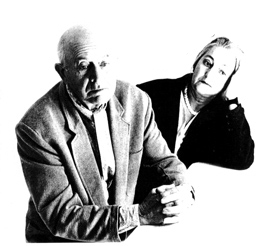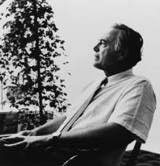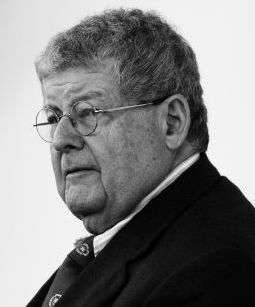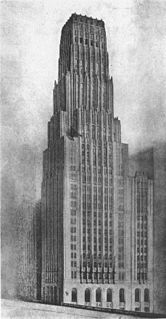Related Research Articles

Ludwig Mies van der Rohe was a German-American architect. He was commonly referred to as Mies, his surname. Along with Alvar Aalto, Le Corbusier, Walter Gropius and Frank Lloyd Wright, he is regarded as one of the pioneers of modernist architecture.

The International Style or internationalism is a major architectural style that was developed in the 1920s and 1930s and was closely related to modernism and modernist architecture. It was first defined by Museum of Modern Art curators Henry-Russell Hitchcock and Philip Johnson in 1932, based on works of architecture from the 1920s. The terms rationalist architecture and modern movement are often used interchangeably with International Style, although the former is mostly used in the English-speaking world to specifically refer to the Italian rationalism, or even the International Style that developed in Europe as a whole.

Modern architecture, or modernist architecture, was an architectural movement or architectural style based upon new and innovative technologies of construction, particularly the use of glass, steel, and reinforced concrete; the idea that form should follow function (functionalism); an embrace of minimalism; and a rejection of ornament. It emerged in the first half of the 20th century and became dominant after World War II until the 1980s, when it was gradually replaced as the principal style for institutional and corporate buildings by postmodern architecture.

Alison Margaret Smithson and Peter Denham Smithson were English architects who together formed an architectural partnership, and are often associated with the New Brutalism.

The buildings and architecture of Chicago reflect the city's history and multicultural heritage, featuring prominent buildings in a variety of styles. Most structures downtown were destroyed by the Great Chicago Fire in 1871.

The Museum of Contemporary Art (MCA) Chicago is a contemporary art museum near Water Tower Place in downtown Chicago in Cook County, Illinois, United States. The museum, which was established in 1967, is one of the world's largest contemporary art venues. The museum's collection is composed of thousands of objects of Post-World War II visual art. The museum is run gallery-style, with individually curated exhibitions throughout the year. Each exhibition may be composed of temporary loans, pieces from their permanent collection, or a combination of the two.

Harry Mohr Weese was an American architect who had an important role in 20th century modernism and historic preservation. His brother, Ben Weese, is also a renowned architect.

Stanley Tigerman was an American architect, theorist and designer.

James Ingo Freed was an American architect born in Essen, Germany during the Weimar Republic. After coming to the United States at age nine with his sister Betty, followed later by their parents, he studied at the Illinois Institute of Technology, where he graduated with a degree in architecture.
Benjamin Horace (Ben) Weese in Evanston, Illinois is an American architect hailing from Chicago, and a member of the architects group, the Chicago Seven. Weese is the younger brother of Chicago architect Harry Weese.

The Contemporary Arts Center (CAC) is a contemporary art museum in Cincinnati, Ohio and one of the first contemporary art institutions in the United States. The CAC is a non-collecting museum that focuses on new developments in painting, sculpture, photography, architecture, performance art and new media. Focusing on programming that reflects "the art of the last five minutes," the CAC has displayed the works of many now-famous artists early in their careers, including Andy Warhol. In 2003, the CAC moved to a new building designed by the late Zaha Hadid.
Chicago firm Nagle Hartray Architecture was founded in 1966. The firm's early reputation was grounded in single-family and multi-family housing. Recent and current projects reflect diversification of the former focus, emphasizing educational, spiritual, civic, and media communication programs. Nagle Hartray has received over 75 industry design awards to date. In 2017, the firm merged with Sheehan Partners to form Sheehan Nagle Hartray Architects.

James Lee Nagle was an American architect practicing in Chicago. He was noted for being part of the Chicago Seven that supported a diversity in architectural styles beyond internationalism.

Gary Berkovich, AIA, NCARB is an American and Soviet architect, and the first Soviet architect of 1960s – 1980s immigration wave, who had opened his office in the United States. Author of about 200 projects of residential and public buildings in the USSR and in the USA. He is a winner of the architectural competitions in the Soviet Union and in the United States. He is also an author of books and professional articles.
Thomas H. Beeby is an American architect who was a member of the "Chicago Seven" architects and has been Chairman Emeritus of Hammond, Beeby, Rupert, Ainge Architects (HBRA) for over thirty-nine years.

Eliel Saarinen's Tribune Tower design or the Saarinen tower are terms used to describe the unnamed and unbuilt design for a modernist skyscraper, created by Finnish architect Eliel Saarinen and submitted in 1922 for the Chicago Tribune's architectural competition for a new headquarters. The winning entry, the neo-Gothic Tribune Tower, was constructed in 1925. Saarinen's entry came in second place yet became influential in the design of a number of future buildings.
Cosentini Associates is an engineering firm which provides consulting engineering services for the building industry.
George Joseph Ranalli is an American modernist architect, scholar, curator, and fellow of the American Institute of Architects. He is based in New York City.
Margaret McCurry is an American architect and a Fellow of the American Institute of Architects.
Herb Greene, in Oneonta, New York, is an American architect, artist, author and educator. Greene's architecture practice was based in Kentucky, Oklahoma and Texas. His built projects are known for an original interpretation of organic design.
References
- 1 2 3 Blair Kamin, "Adding up the other Chicago Seven". Chicago Tribune. 2 October 2005. The Chicago Tribune. Retrieved 9 February 2011.
- ↑ Lynn Becker, "Return of the Chicago Seven". ArchitectureChicago PLUS. 14 September 2005. Blogspot. Retrieved 9 February 2011.
- ↑ "The Chicago Seven, plus one, design an 'exquisite corpse' to create a row of post-modernist townhouses." Architectural Record. June 1978:39.
- ↑ Oral History of James Lee Nagle, interviewed by Annemarie van Roessel, compiled under the auspices of the Chicago Architects Oral History Project, the Ernest R. Graham Study Center for Architectural Drawings, Department of Architecture, the Art Institute of Chicago. 2000, p. 83.
- ↑ Charles Jencks, The language of post-modern architecture. The fifth edition, Academy Editions, London 1987, p. 134 (with illustrations).
- ↑ Charles Waldheim and Katerina Ruedi. Chicago Architecture: Histories, Revisions, Alternatives. Chicago: University of Chicago Press, 2005.